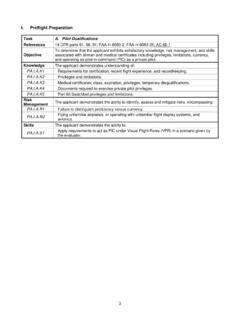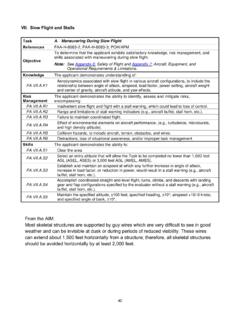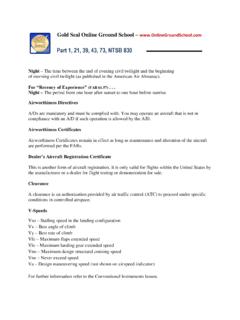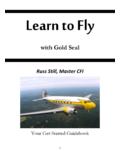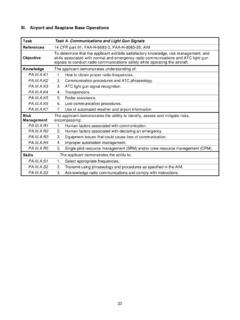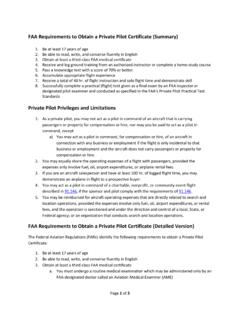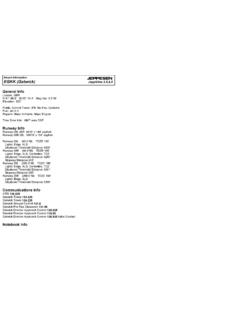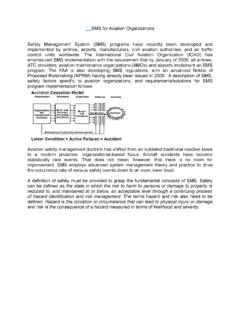Transcription of IV. Takeoffs, Landing and Go-Arounds
1 IV. Takeoffs, Landing and Go-Arounds Task C. Soft-Field takeoff and Climb (ASEL). References FAA-H-8083-2, FAA-H-8083-3; POH/AFM. To determine that the applicant exhibits satisfactory knowledge, risk management, and Objective skills associated with a soft-field takeoff , climb operations, and rejected takeoff procedures. Knowledge The applicant demonstrates understanding of: Effects of atmospheric conditions, including wind, on takeoff and climb performance. VX and VY. Appropriate aircraft configuration. Ground effect. Importance of weight transfer from wheels to wings. Left turning tendencies. Risk The applicant demonstrates the ability to identify, assess and mitigate risks, Management encompassing: Selection of runway based on pilot capability, aircraft performance and limitations, available distance, and wind. Effects of: a. Crosswind b. Wind shear c. Tailwind d. Wake turbulence e. Runway surface/condition Abnormal operations, to include planning for: a. Rejected takeoff b.
2 Engine failure in takeoff /climb phase of flight Collision hazards, to include aircraft, terrain, obstacles and wires. Low altitude maneuvering/stall/spin. Distractions, loss of situational awareness, and/or improper task management. Skills The applicant demonstrates the ability to: Complete the appropriate checklist. Make radio calls as appropriate. Verify assigned/correct runway. Ascertain wind direction with or without visible wind direction indicators. Position the flight controls for the existing wind conditions. Clear the area, taxi into takeoff position and align the airplane on the runway centerline without stopping, while advancing the throttle smoothly to takeoff power. Confirm takeoff power and proper engine and flight instrument indications prior to rotation. Establish and maintain a pitch attitude that will transfer the weight of the airplane from the wheels to the wings as rapidly as possible. Lift off at the lowest possible airspeed and remain in ground effect while accelerating to VX.
3 Or VY, as appropriate. Establish a pitch attitude for VX or VY, as appropriate, and maintain selected airspeed +10/-5 knots during the climb. Retract Landing gear and flaps after a positive rate of climb has been verified or in accordance with aircraft manufacturer's guidance. Maintain VX or VY +10/-5 knots to a safe maneuvering altitude. Maintain directional control and proper wind-drift correction throughout takeoff and climb. Comply with noise abatement procedures. 22. IV. Takeoffs, Landing and Go-Arounds Task D. Soft-Field Approach and Landing (ASEL). References FAA-H-8083-2, FAA-H-8083-3; POH/AFM. To determine that the applicant exhibits satisfactory knowledge, risk management, and Objective skills associated with a soft-field approach and Landing with emphasis on proper use and coordination of flight controls. Knowledge The applicant demonstrates understanding of: A stabilized approach, to include energy management concepts. Effects of atmospheric conditions, including wind, on approach and Landing performance.
4 Wind correction techniques on approach and Landing . Risk The applicant demonstrates the ability to identify, assess and mitigate risks, Management encompassing: Selection of runway based on pilot capability, aircraft performance and limitations, available distance, and wind. Effects of: a. Crosswind b. Wind shear c. Tailwind d. Wake turbulence e. Runway surface/condition Abnormal operations, to include planning for rejected Landing and go-around. Collision hazards, to include aircraft, terrain, obstacles and wires. Low altitude maneuvering/stall/spin. Distractions, loss of situational awareness, and/or improper task management. Skills The applicant demonstrates the ability to: Complete the appropriate checklist. Make radio calls as appropriate. Ensure the aircraft is aligned with the correct/assigned runway. Scan the Landing runway and adjoining area for traffic and obstructions. Consider the wind conditions, Landing surface, obstructions, and select a suitable touchdown point.
5 Establish the recommended approach and Landing configuration and airspeed, and adjust pitch attitude and power as required to maintain a stabilized approach. Maintain recommended airspeed, or in its absence, not more than VSO, +10/-5 knots, with wind gust factor applied. Maintain crosswind correction and directional control throughout the approach and Landing . Make smooth, timely, and correct control inputs during the round out and touchdown and, for tricycle gear airplanes, keep the nose wheel off the surface until loss of elevator effectiveness. Touch down with minimum sink rate, no side drift, and with the airplane's longitudinal axis aligned with the center of the runway. Maintain elevator as recommended by manufacturer during rollout and exit the soft area at a speed that would preclude sinking into the surface. Execute a timely go-around if the approach cannot be made within the tolerances specified above or for any other condition that may result in an unsafe approach or Landing .
6 Maintain proper position of the flight controls and sufficient speed to taxi on the soft surface. 23.
